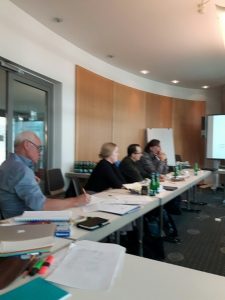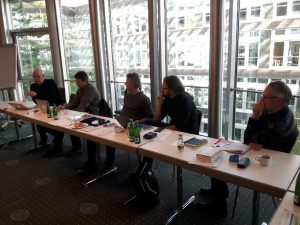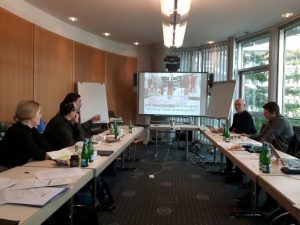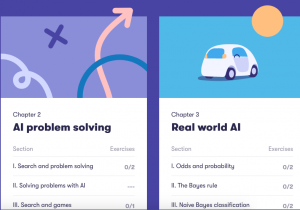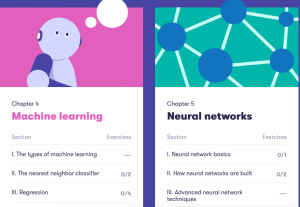In my previous posts I have given an overview of the reports for our ongoing TACCLE4 CPD projects that I had completed so far. At the end I have mentioned that all the reports so far provide contributions to a new framework for developing training for teachers and trainers – with emphasis on promoting digital competences in the context of vocational learning. Already in the previous reports I had made the point that this should be based on the Theme Room training concept that was initiated and implemented in the Learning Layers project. During last week I have written a draft report to outline such a framework. Below I will present some background information and the concluding section of the report. I think that they will give an idea, what kind of framework is taking shape.
The idea of Theme Room Training – oringins and new perspectives
This framework is being prepared as a final product of the EU-funded project TACCLE4-CPD. The project has continued the work of earlier TACCLE projects in promoting digital competences of school teachers. However, concerning the field of VET, this project drawn upon the experiences of the EU-funded project Learning Layers (LL). The LL project developed digital tools and training concepts to support workplace-based and vocational learning. The concept of “Theme Rooms” was developed as a part of the LL project to promote digital competences of vocational trainers.
The training in ‘Theme Rooms’ was initiated by the above-mentioned trainers who wanted to develop a more systematic training arrangement. With this approach they wanted to reach all training staff in their organisation. In this way they wanted to promote the use of digital tools in all areas of apprentice training.
The idea of Theme Rooms was based on the following pedagogic principles:
- Combination of real and virtual learning spaces for focused thematic blocks for promoting digital competences;
- Signing in into ‘theme rooms’ for completing the learning sessions with exercises and then signing out (with a flexible tempo);
- Working together in teams in terms of peer learning and peer tutoring;
- Rotating between different themes in order to reach common awareness of the subject matter and to develop a common competence base.
The concept of Theme Room training was put into practice as a staff training campaign during one month. This training campaign based on the Theme Room concept helped the trainers to become users of the LTB in their own training. Now, in the current situation, it is possible to identify many parallel approaches to introduce digital tools and new media into vocational learning. At the same time there are new qustions concerning the significance of digital technologies in the context of vocational education and training (VET). These are taken up in the new framework.
What does the new framework stand for?
The main elements of the framework are thematic blocks that can be used as a basis for the Theme Rooms of the updated training concept. The following set of thematic blocks is presented in the further sections below:
In the first thematic block the framework draws attention to digital transformation (as a major socio-cultural challenge) and to digitization (as a more specific development). This block invites to think, how VET provisions can prepare for such processes and/or provide co-shaping contributions.
The second thematic block discusses the readiness of older and younger learners to use digital media and tools in the context of vocational learning. This block invites to think, how older teachers, trainers and workplace mentors can find their own ways to use such tools to promote vocational learning. Also, it invites to think, how younger learners can best familiarise themselves with work processes, uses of traditional tools and digital tools in their own learning.
The third thematic block presents a set of parallel “Innovation paths” for introducing digital tools into vocational learning contexts and to enhance the digital competences of teachers, trainers and learners. Four of these paths have been named on the basis of specific projects or their final products – the Kompetenzwerkstatt, Learning Toolbox, Brofessio and CARO paths. The fifth path refers to smart uses of Open Educational Resources (OER). This block invites to think, what kind of vocational learning contexts are relevant for the user and what can be learned from the exemplary cases.
The fourth thematic block presents insights into the TACCLE4 CPD Routemap tool and its uses for organisational planning (of the use of ICT resources) and development of training (with focus on promoting digital competences). For both purposes the Routemap outlines levels of proficiency with corresponding criteria. In this way the tool invites to think, at what stage is the organisation regarding its use of ICT resources and what kind of steps can be taken with the help of training.
Altogether, the framework invites the readers to think of their own solutions and to find their own ways to promote digital competences in their field. Thus, the framework provides starting points and gives further impulses and references for further developmental work.
—
I guess that this is enough of the idea of the Theme room Training 2020 framework. I need to emphasise that it is still under construction. As I see it, the texts for the thematic blocks have already been shaped. Yet, each block needs a further layer for comments, questions, resources and impulses. So, there is still some more work to be done.
